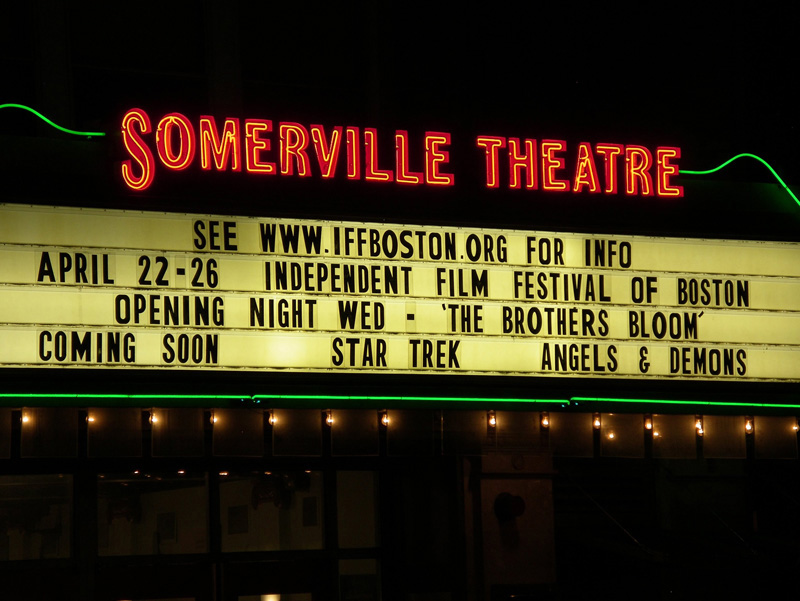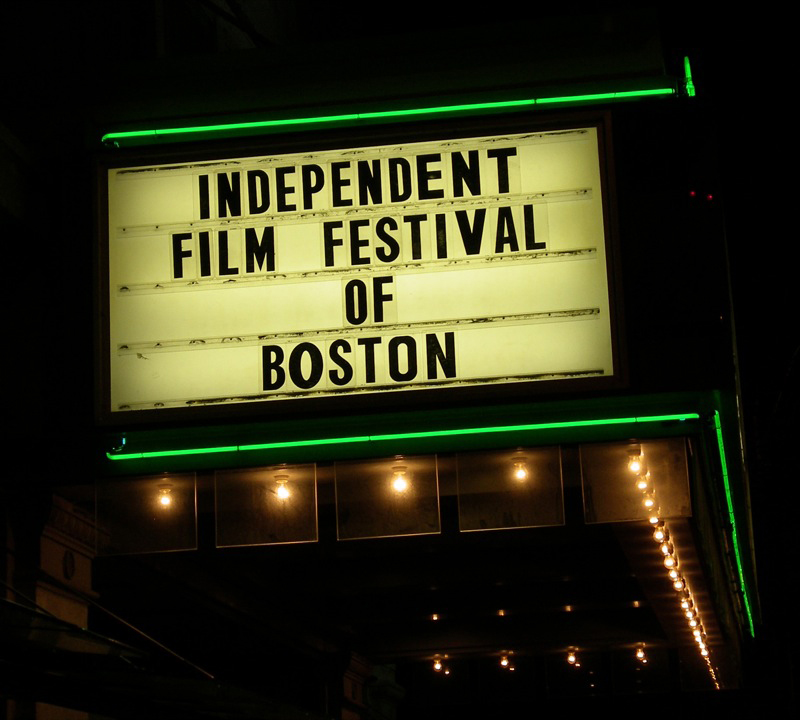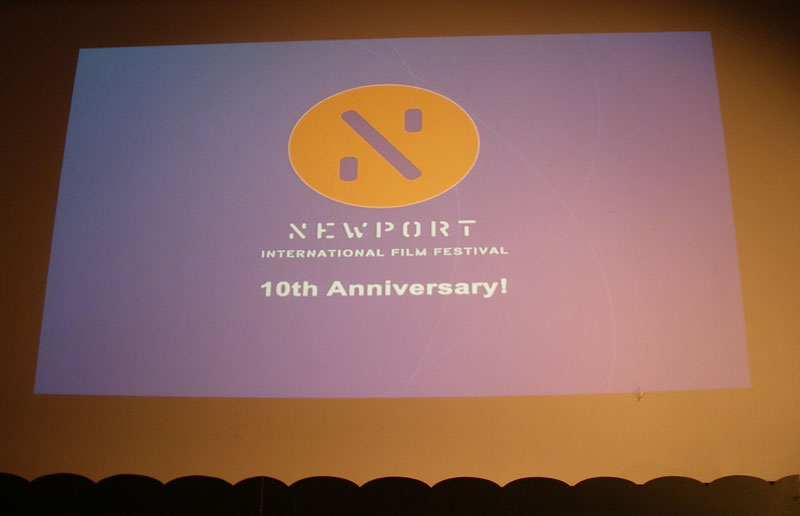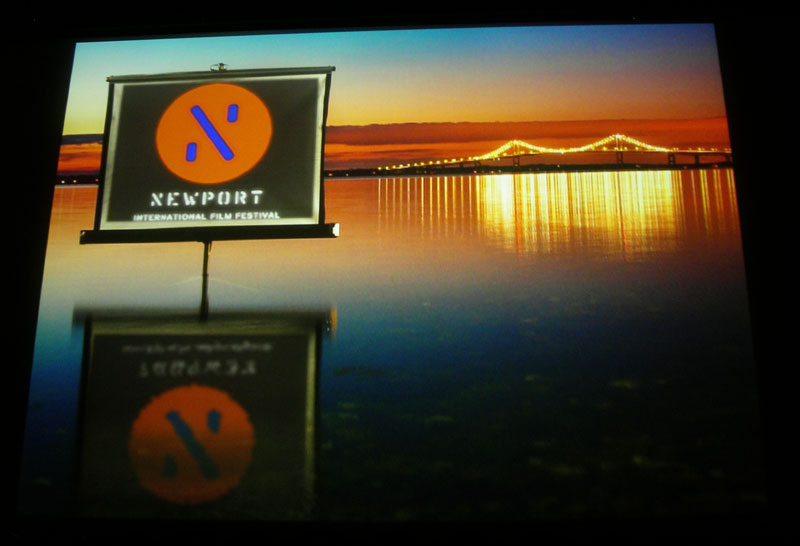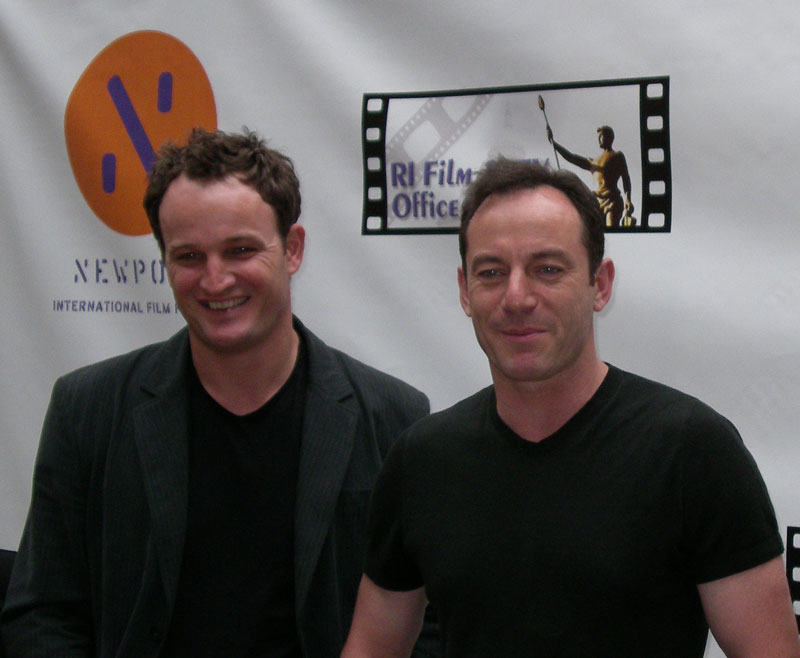|
|
||
|
Pro Tools
FILMFESTIVALS | 24/7 world wide coverageWelcome ! Enjoy the best of both worlds: Film & Festival News, exploring the best of the film festivals community. Launched in 1995, relentlessly connecting films to festivals, documenting and promoting festivals worldwide. Working on an upgrade soon. For collaboration, editorial contributions, or publicity, please send us an email here. User login |
IFFBoston 2008 - Who Makes the Call?At the Opening Night party for Independent Film Festival Boston 2008, I asked Managing Director Brian Tamm about the festival’s selection process and whether they keep any themes in mind when filling out the schedule. His response was: “We just try to select the best films we can. You guys [the press] tell us what the themes are.”
Well, let’s see what they came up with. With the Opening Night thriller’s frostbitten Siberian north (Transsiberian) and the Closing Night documentary’s frozen Antarctic south (Encounters at the End of the World) bracketing films from across Asia, the Middle East, Europe, North America and back into the Pacific, the 2008 IFFBoston spans the globe from top to bottom and side to side. Besides the films in English, there are subtitled films not only in Spanish, French, Belgian, Japanese, Cantonese and Mandarin but also in Greek, Mongolian, Greenlandic, Filipino, Eskimo, Dari and Pashtu. There is even one whole film (The Linguists) that searches the planet to document the vast catalog of human languages and the fragility of many that remain before their voices fall mute, lost to history. But I wouldn’t say that “World Cinema” was really a theme of IFFB ’08. This year’s slate featured an unusually high number of films with strong female characters (or personas, in the case of documentaries) – a welcome departure for an industry with a historic dearth of good roles for women relative to those for men. In some of the films (examples: Turn the River, Jetsam, Lioness, Frontrunner), it seems obvious that this will be the case based on a cursory look at the film summary. In others, this strength becomes apparent only as the film develops (Transsiberian, Ballast, Natural Causes). That said, 2008 isn’t IFFB’s Year of the “Chick Flicks” because they also screen a fair share of films with few, if any, a plot-pivotal women in sight (Mongol, Flash Point, Saviours, Severed Ways: the Norse Discovery of America). Then there’s the suite of films for the “Freaks, Geeks and Nerds”. Harry Potter (We Are Wizards), online gaming (Second Skin), anime (Vexille), martial arts (Flash Point), time travel (Time Crimes), nerdcore hip-hop (Nerdcore Rising), good old-fashioned schlock horror (Blood Car, The Rambler), and more – it’s all there. But it’s not all that’s there.
What about the individual films?
Brad Anderson’s festival opener, Transsiberian, is one of those classic taut dramas staged primarily on a train - combining the isolation of the characters with the inexorable motion of the plot. During Q&A, Sir Ben Kingsley made note of an old Russian phrase he picked up while shooting the film: With a lie you can go forward, but you can never go back. The truth of that adage is proven time and again in this film. In this case, the travelers are unwittingly pulled deeper into a dangerous morass with each mile of track covered and each lie told. (Think Uncle Remus’ Tar Baby mixed with Blood Simple, shot on a train that runs through the exteriors of the latter reels of Doctor Zhivago.) At some point while watching this movie you will find that what you thought was happening isn’t what’s actually happening and that realization could be triggered by something as simple as a phone call or the opening of a door.
Lance Hammer’s Ballast is set in rural Mississippi and is a film that begins with a death, yet ends with three lives. Cinematically, it is the diametric opposite of Transsiberian, but hits the right notes for a much more intimate drama. Rather than casting accomplished veterans and blocking out complex character interaction, Hammer shot purposely with a cast of locals unaccustomed to hitting marks or repeating lines from shot to shot. Each take is done entirely with handheld cameras and natural light to allow for 360 degrees of movement from each character as they react in the moment. Instead of shooting the high contrast, sometimes blinding, snows across the breadth of Asia, Hammer shoots in low light with aperture wide open to give a shallow depth of field and brings in the broad flat vistas of the Delta almost as another character, reminiscent of Thomas Hardy’s use of the Heath in Return of the Native. Ultimately, the dramatic tension here comes not from threat of physical danger, but from navigating the emotional minefields of frayed family relationships.
Another film with a strong sense of place is Sergei Bodrov’s Mongol. Planned as the first chapter in a trilogy, Mongol takes us from vulnerable childhood to the brink of dominance in the life of Temudjin, the man the world would later know as Genghis Khan. Rather than simply the one-dimensional warlord that history would project, we see a full person, from strife to triumph: a boy struggles to become a man, a childhood crush blossoms into a wife and confidant, and a close ally risks being branded as an avowed enemy. However, with due respect to the scholarship that went into the script and the logistics of the swift, stirring battle scenes, what many will most remember about this film is the breathtaking scenery. Bodrov uses the Mongolian Steppe the way that David Lean used the Arabian Desert. The sprawling scope of the landscape swallows the viewer into another world. This film is a great example of why some films are best seen in cinemas on the large screen instead of on cable or DVD, no matter how big the home theater.
For warrior life on a smaller scale, there’s Tony Stone’s Severed Ways: the Norse Discovery of America. Inspired by the Norse turn-of-the-first-millennium Vinland Sagas, Severed Ways follows two Vikings left for dead and abandoned on a forested North American coast as they try to hike their way north and, hopefully, to a Viking settlement. With minimal dialogue and minimal cast, the film is paced like a story told about two guys taking a walk. Visually, the travelogue of New England and Canadian wilderness is pervasive enough that I swear I could smell damp bark and feel pine needles underfoot. Watching the lost travelers make camp set to a heavy metal soundtrack might make one think of a Frazetta or Vallejo painting come to life. For the contemplative viewer, Severed Ways reveals a slowly-evolving character study. For someone looking for a few hours of hack-and-slash distraction, this isn’t that movie.
If you want pure fun, there’s Alex Orr’s made-for-midnight horror-comedy, Blood Car. Orr’s original plan was to create a film about a racist sea monster. While riding around in his beat up car contemplating the incredible logistics of shooting such a film, he came upon a different idea and shot that instead. He shot for twelve days, cut for five months, hated what he had, and reshot. What he came up with is a world with unaffordable gasoline and a kindly vegan kindergarten teacher (“Archie Andrews”) experimenting with an alternative fuel made of wheatgrass. Judging by the title, you can guess that all goes horribly awry. Amongst the ensuing carnage, caring and comedy, Orr manages to include references to Natural Born Killers, Psycho, Last Tango in Paris, Love and Death, Rebecca, Bucket of Blood, Pickup on South Street, and – completely unintentionally (I asked three times) – Breaking Away. As an example of the no-holds-barred attitude held in making this film, Orr was asked at Q&A whether he had any reservations about shooting (with a gun) school kids in a scene. His response was a quick “No”, followed by the observation that he went ahead and killed kids and dogs because he might not be able to, or be as free to, if doing another film later with a bigger budget and more oversight. Did I mention that this was funny?
Finding a blood car of a different kind, we have Stuart Gordon’s Stuck. Based on a real life incident, which was also the basis of a CSI episode, the bulk of the film has Stephen Rea lodged in Mena Suvari’s windshield after a traffic accident. No one is dead. He’s just, well, stuck. Less funny and less gory than Blood Car, on some level Stuck is more cringe-worthy because the situation is more real – not surprising considering that some version of it did happen. That said, I also found the scene with the dog funny in this movie as well, and I like dogs.
Of local note is the world premiere of Twelve, a film made in and around Boston. The source of the title is that the film is really composed of twelve ten-minute shorts shot by a group of twelve area filmmakers. The premise for the project was that everyone involved must contribute to each film, and everyone is allowed to write and direct one of them. Shot over the course of a year, each director is given a specific month to capture the spirit of, and to shoot within. The result is a collaborative work that is greater than the sum of its individual shorts. As the year passes, through-lines develop and themes return. By the time December has wound down, we have seen a collage of viewpoints that coalesce into a distinct take on Boston.
2008’s IFFB documentaries ranged from fun to cautionary to inspirational.
Crawford takes a look at a small town in rural Texas that is thrust upon the world stage when a man about to run for President moves to town and eventually takes office. From press to protesters to tourists, all coming in waves, this town and its residents are permanently impacted - some for the better, some for the worse, some for the tragic.
Whereas Crawford lets us see how one man draws out the media, Eleven Minutes is the flip side of that coin as media draws out the man. Jay McCarroll was just another aspiring fashion designer until Bravo’s Project Runway named him winner of the first season. Eleven Minutes follows McCarroll for a year as he prepares for his moment in the sun, an eleven minute runway show at Fashion Week. I have to admit that I had never seen Project Runway and was apathetic about seeing this film until I bumped into IFFB’s Program Director Adam Roffman in the lobby of the Somerville Theater. Running on fumes as the festival was drawing to a close, I was contemplating passing on a late Monday show and getting a good night’s sleep. Adam convinced me that I should stay to watch this, if only for McCarroll himself. I believe the quote was “You’ll like the movie, but stay for the Q&A.” Good call, Adam. McCarroll’s larger–than-life personality explodes on the screen. He could have been crafting a fashion show, outlining a DIY remake of an unfinished basement, or explaining the rigors of medical school and it still would have drawn in most viewers. The Q&A was fun too (see the video clips elsewhere on this site), but the film is essentially one continuous pre-recorded Q&A with McCarroll at the center of it all.
Meadowlark is Taylor Greeson’s autobiographical exploration of pivotal and traumatic events from his childhood that helped to form the man he is today. Traveling through the physical world and his own memories, Greeson returns to his childhood home to confront his own emotions and the men who took his virginity and his brother’s life - with unexpected results. Rather than tying everything up in a neat package, this journey opens as many doors for Greeson as it closes, yet allows him to move on in a way that he had not intended.
Saviours traces the trajectory of young Irish boxers training at St. Saviours Olympic Boxing Academy in the north of Dublin as they compete for the honor of representing their country at the Olympic Games. In this no-nonsense environment - the inspiration for the gym itself was the Montreal Games of 1976 – it is up to each boxer each day to show what he’s made of or be shown the door. With so many obstacles to overcome inside the ring and out, it is always in doubt which boxers will reach for the brass ring and get it and which will reach their limit and get out. (For more about this film, see the excusive one-on-one interviews with co-director Liam Nolan elsewhere on this site.)
We Are Wizards reveals the little known world of Harry Potter-inspired artists and the fans who love them. Josh Koury spent three years making this film and released it to coincide with the climax of Harry Potter mania, as fans of the books await the final volume in the series. The film focuses much of its time on the phenomenon of “Wizard Rock” where bands like Boston’s Harry and the Potters, Woonsocket’s Draco and the Malfoys, and The Whomping Willow write songs written from the point of view of characters in the series and perform their act in front of small but appreciative crowds. Harry and the Potters is actually a two-man act composed of a pair of brothers who both wanted to be Harry, so they agreed that one could be Harry: Year Seven and the other Harry: Year Four. While many will have never heard of the genre of Wizard Rock (or its offshoot “Dragon Rock” as performed by the Hungarian Horntails, a duo of boys aged seven and four) the Potters played 100 shows in 2007 from California and Vancouver to Boston to Europe with 78 of those coming in the summer. That’s a lot of bookings. Not to be forgotten, there is also Brad Neely’s bizarre and humorous parody, “Wizard People”, which serves as an alternate soundtrack to the first of the Harry Potter movies. This film also shows the impact such a beloved story can have on a culture as we see fandom give rise to activism regarding copyright law and religious resistance to a story about magic that leads one teen to borrow a Potter book and secret herself away in an attic to read it like Anne Frank hiding from Nazi persecution. (For examples of acoustic and electric performances, see live concert video clips elsewhere on this site.)
At the intersection of fun and obsession is Second Skin. Ostensibly, this is a film about the world of online role playing games. What lurks behind this seemingly harmless pastime is the seductive ability to remake oneself in an image of one’s own design and the double-edged sword of having the power to be whoever you want to be in a virtual reality where everyone else has the power to do the same thing. The more time you spend playing, the more successful you’re likely to be – and the less time you have to spend in the physical world where jobs and relationships expect your presence and landlords expect your rent. Such situations lead to the blurring of lines between physical and virtual realities, where people will pay real world money for rare virtual world artifacts and a currency exchange industry has sprouted where Asian-based “gold farms” employ people to exploit a loophole in the gaming rules to generate piles of artificial wealth to be swapped for hard cash. One of the most telling observations of the film was uttered by a recovering gaming addict and veteran of a 12-step program as he saw another young man being drawn into the online gaming world: “Don’t waste day and night playing a game just because it’s there. Crack’s out there. Why don’t we smoke it? Oh wait, that would actually require physical activity to go get it and human interaction with the dealer…” An equally telling audience reaction occurred during the screening of the 12-step program when a gamer is asked to ceremonially destroy his gaming disc. The tension in the theater was palpable and as he snapped this disc in half, there were audible gasps all around. At the moment of snapping, one viewer let out a reflexive lament “oh!… wow…”. It seems we had some gamers in the crowd as well.
Both cautionary and inspirational is The Greening of Southie by Ian Cheney (co-creator of King Corn). Cheney follows the construction of Boston’s first “green” residential building, the Macallen Building, as it strives for a Gold rating on the LEED scale, which measures the ecological sustainability of new and renovated structures. Along the way, we see the impact such an effort has on the neighbors, the tenants, the construction workers and even their families as the project moves along. If you’ve ever wanted to know more about “green buildings”, this is as good a place to start as any. Werner Herzog is not the first person that one would think of as the director of a documentary set in Antarctica, but that’s what we have in the Closing Night’s Encounters at the End of the World. Arriving in the same bay as Shackleton’s doomed Endeavor expedition with his equipment chained to the deck of a transport, Herzog leaves no doubt that he would not be shooting yet another movie about penguins. Expressing his distaste for what he sees as contrived zoology, he asks “Why don’t monkeys straddle a goat and ride off into the sunset?” and with that, we know we’re in for a journey where only Herzog can take us. More than just the perusing the landscape, Herzog searches for the inspiration that would lead people to come here to live in a place that, to many, would be uninhabitable. At the same time, he does look at the strange fauna and the unique environment in which they live. (Yes, there are also penguins.) In so doing, he brings a sense of scale to what is at stake as we face a world of changing climate. Referring to one ice mass, he explains that this is not only bigger than the iceberg that sank the Titanic, bigger than the Titanic itself, but it is bigger than the country that built the Titanic. Further, he points out that most of Antarctica is covered in nine thousand feet of ice. Looking back, this makes an interesting counterpoint to last year’s IFFB Closing Night film, Time and Tide, where the destruction of environment in one location (Antarctica) is leading to the death by drowning of the other (Tuvalu). So… Where does that leave us with regards to my initial question? Well, ultimately, I guess Brian was right. They selected a great slate of films. It’s up to you to decide what themes lay within. 23.04.2009 | Todd's blog Cat. : 2008 Adam Roffman Alex Orr America Anne Frank Antarctic Antarctica Archie Andrews Asia Asian Ben Kingsley Blood Car Boston Boxer Brad Anderson Brad Neely Brian Tamm California co-director Company Technology David Lean Dealer Director Disaster Disaster Draco and the Malfoys Dragon Dublin Entertainment Entertainment Europe fashion designer Film Flash forward Harry and the Potters Harry and the Potters Harry Potter Harry Potter and the Deathly Hallows – Part 1 Ian Cheney IFFB IFFBoston Independent Film Festival of Boston Jay McCarroll Josh Koury King Lance Hammer Liam Nolan Macallen Building Managing Director Mena Suvari metal Middle East Mississippi Montréal New England North America Paris Person Career Politics Politics president Saw Sergei Bodrov Somerville Sports Sports Stephen Rea Stuart Gordon Taylor Greeson teacher Texas the Opening Night party for Independent Film Festival Thomas Hardy Time and Tide Tony Stone Vancouver virtual reality Werner Herzog Werner Herzog Wizard Independent FESTIVALS
|
LinksThe Bulletin Board > The Bulletin Board Blog Following News Interview with IFTA Chairman (AFM)
Interview with Cannes Marche du Film Director
Filmfestivals.com dailies live coverage from > Live from India
Useful links for the indies: > Big files transfer
+ SUBSCRIBE to the weekly Newsletter Deals+ Special offers and discounts from filmfestivals.com Selected fun offers
> Bonus Casino
User imagesThe EditorUser contributions |



















